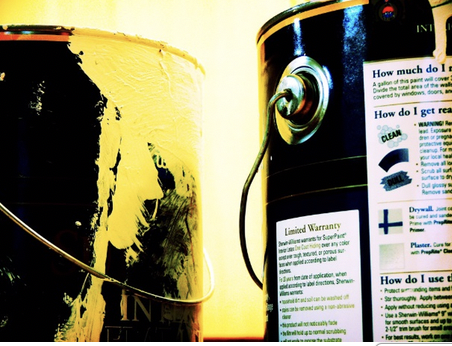Courtesy : greenmanual.rutgers.edu
Non-toxic or low-emitting materials release relatively low levels of odorous, irritating, toxic, or hazardous substances unhealthy to building occupants.[1] Volatile organic compounds (VOCs) (including formaldehyde), particulates, and fibers include substances often emitted from building materials that can adversely impact human health.
Volatile Organic Compounds (VOCs) contain carbon molecules and can vaporize from material surfaces into indoor air at average room temperatures (a process known as off-gassing).[2] A non-toxic material must meet different thresholds of VOC emissions compliance depending on the material.[3] Found in many everyday products and building materials, VOCs can escape into the air and cause illness and allergic reactions. Studies have linked elevated levels of VOCs and interior pollutants to health concerns that cause eye, nose and throat irritation, headaches, loss of coordination, nausea, and other health problems. [4] People with respiratory problems, children, seniors and people with compromised immune systems are at higher risk to reactions from exposure than general population.
According to the EPA, concentrations of many VOCs are consistently higher indoors (up to ten times) than outdoors. Paints, sealants, manufactured wood products, and adhesives as well as some furnishings and carpet systems often release VOCs. Inherently non-emitting sources of VOCs such as stone, ceramic, powder-coated metals, plated or anodized metal, glass, concrete, clay, brick, and unfinished or untreated solid wood do not require VOC emissions testing if they do not include VOC emitting surface coatings, binders, or sealants.[5]
Formaldehyde (CH2O), a known carcinogen, is a colorless gas with a strong odor that can cause eye, nose, skin, and lung irritations. It forms an essential component of several polymers used in many building materials including urea formaldehyde, phenol formaldehyde, and melamine resin. When selecting safe, non-toxic materials, avoid building materials and products containing formaldehyde resins. Pressed-wood products, such as particleboard, oriented strand board (OSB), plywood, medium density fiberboard, glues and adhesives, permanent-press fabrics, paper product coatings, and specific insulation materials often use formaldehyde resins.[6] More information about formaldehyde can be found through resources such as the US EPA website. If a formaldehyde-containing product is purchased, it should be aired out before it is used.
Figure 1 – Paint cans (Source: Maury McCown)
How to Incorporate Non-toxic Materials
Increased awareness about possible health risks and indoor air quality concerns have helped to expand the market for non-toxic materials. Low-emitting material credit requirements by GGBC and other green building certifications have led to a demand for products lower in VOCs and toxic chemicals.[7] Several certification programs, standards, and criteria for selecting and evaluating sustainable materials include GREENGUARD (indoor air quality certification), Green Label Plus (carpets/rugs), Green Seal, and Scientific Certification Systems.
The definition of a “low” concentration of VOC emissions varies according to the product type. For example, for interior paints and coatings, low-VOC emitting products have concentrations below 50 g/L; a zero-VOC paint has fewer than 5 grams per liter.[8] Paints and finishes come in either oil-based formulas or latex (water) based, which are generally less toxic and less VOC-emitting than oil-based paints.[9] Not all latex-based formulas are low in VOC’s, however, and a few oil-based products now qualify as low-VOC. For independent certifications and standards, see greenseal.org and greenguard.org (which measures VOC emissions).
There are many hard, low-formaldehyde flooring materials on the market. Formaldehyde occurs naturally in wood and making wood-containing flooring products are never 100% formaldehyde free. By using materials such as concrete and recycled tile, a homeowner




